 |
Native of New South Wales from Wellington Valley. The man's body shown the cicatrices of initiation and he holds a spear thrower. In a companion image, held by the National Library, Earle painted this man's back. The back image also shows pronounced cicatrices and, more clearly, the apparel made of strips of possum skin. A curved weapon is tucked into the waist band and the hair is decorated with feathers and tied back with a thong. The front image is incorporated into the landscape of Wellington Valley with the commandant's house.
Augustus Earle (1793-1838), watercolour c.1826-7. Rex Nan Kivell Collection NK12/24, National Library of Australia.
|
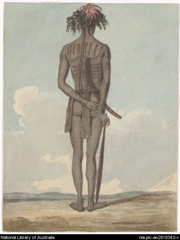 |
Native of New South Wales (c1826)
Augustus Earle (1793-1838), watercolour c1826. Rex Nan Kivell Collection NK12/32, National Library of Australia.
|
 |
Wellington Valley, New South Wales, looking East, from Government House, showing part of the Commandant's house and a Wiradjuri warrior in the foreground and the huts of the penal settlement, established in 1823, in the middle distance.
Augustus Earle (1793-1838), watercolour, c.1826-7, 20 x 37.5 cm. Inscription: '24. Wellington Valley, New South Wales, looking East, from Government House'. Rex Nan Kivell Collection NK12/24, National Library of Australia.
|
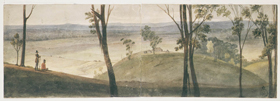 |
View of a Hassall property, possibly that of James or Jonathan Hassall, near Molong, NSW.
Unsigned and undated watercolour attributed to Augustus Earle, c.1826-7, 17.7 x 51.7 cm. Inscription: 'Moalong Plains near Wellington Valley. The residence of Mr Hunt, the accomplice of Thomas. H.' Mitchell Library, Sydney.
|
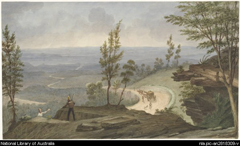 |
King's Table Land, Blue Mountains, New South Wales: the appearance of the new road.
Augustus Earle (1793-1838), watercolour ; 21.3 x 36.2 cm. Rex Nan Kivell Collection NK12/26.
|
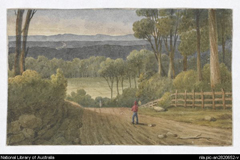 |
A distant view of the Blue Mountains and Lapston [i.e. Lapstone] Hill, New South Wales taken from the Emu Plains Road
[1826?]
Augustus Earle (1793-1838)1 watercolour ; 10.7 x 17.4 cm. Rex Nan Kivell Collection NK12/56.
|
 |
A government jail gang, Sydney, N.S. Wales
Augustus Earle (1793-1838) ..
|
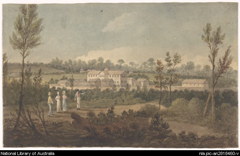 |
Female penitentiary or factory, Parramatta
[1826?]
Augustus Earle (1793-1838) 1 watercolour ; 15.9 x 25.7 cm. Rex Nan Kivell Collection NK12/47.
|
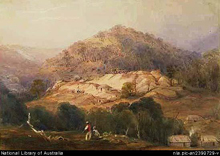 |
View of the Molong Mine, N.S.W.
[1847?]
Conrad Martens (1801-1878), 1 watercolour ; 18.2 x 26 cm. Rex Nan Kivell Collection NK229.
|
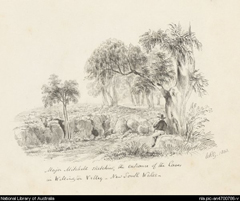 |
Major Mitchell sketching the entrance of the caves in Wellington Valley, New South Wales
1843.
Govett, William Romaine (1807-1848), 1 drawing : pen ; 23 x 29 cm. Title from inscription.; In: Album of William Romaine Govett.; Rex Nan Kivell Collection NK5991/27.
|
 |
View of a property of Thomas Hassall, near Molong, NSW.
Unsigned and undated watercolour attributed to Augustus Earle, c.1826-7, 29.3 x 53.3 cm. Inscription: 'Moalong Plains near Wellington Valley. The residence of Mr Hunt, the accomplice of Thomas. H.' Mitchell Library, Sydney.
|
 |
View of Bathurst, NSW
Unsigned and undated watercolour attributed to Augustus Earle, c.1826-7, 24.2 x 75.5 cm. Inscription: 'Bathurst Plains and Settlement New South Wales'. Mitchell Library, Sydney.
|
 |
The annual meeting of the native tribes at Parramatta, New South Wales, the Governor meeting them [picture] Earle, Augustus, 1793-1838. [1826?] 1 watercolour ; 17.1 x 26 cm.
|
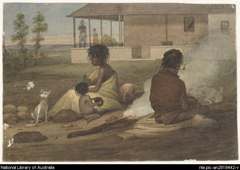 |
An Aboriginal family camping outside a European settler's farmhouse, possibly in the Wellington area of NSW. In the company of two native dogs and wrapped in a blanket, the Aboriginal woman has a child at the breast while a toddler holds a cup and seems to be asking for food.Sitting slightly apart, the Aboriginal man, dressed in European clothes, smokes with his back to the viewer. On the verandah of the European house, a man wearing a top hat surveys the scene with arms folded. His wife stands a little further back, but both seem distanced and disapproving of the native camp. Hackforth-Jones notes a resemblance between the woman (left) and one of the wives of Bungaree portrayed elsewhere by Earle.
Water colour by Augustus Earle, c.1826-7,17.5 x 25.7 cm. Inscription: '45. A Native Family of New South Wales sitting down on an English Settler's Farm'. Rex Nan Kivell Coolection NK12/45, National Library of Australia.
|
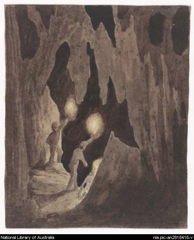 |
Wellington Caves. This is one of three paintings which Augustus Earle executed, probably in 1826, of a torch light visit to the large cave, called 'Mosman's Cave', in Wellington Valley.
|
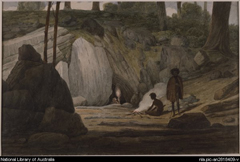 |
Mosman's Cave, Wellington Valley, New South Wales, No. 1 [picture], Earle, Augustus, 1793-1838: 1 watercolour ; 21 x 32.5 cm.
|
| |
|
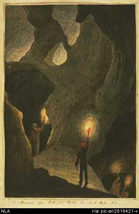 |
Large cavern at Wellington Valley [picture] Day & Haghe. London : Published by T. & W. Boone, [1839] 1 print : lithograph, hand col.; 13.6 x 10.2 cm.
|
 |
Engraving of an Aboriginal burial site from the published journal of Surveyor-General John Oxley during his "Expedition to ascertain the Course of the Lachlan River.' He noted, on 29 July 1817: "Almost directly under the hill near our halting place we saw a tumulus, which was apparently of recent construction. . . It would seem that some person of consideration among the natives had been buried in it, from the exterior marks of form which had certainly been observed in the construction of the tomb and the surrounding seats. . . To the west and north were two cypress tress, distant between 50 and 60 feet. The sides towards the tomb were barked, and curious characters deeply cut upon them, in a manner which, considering the tool they possess, must have been a work of great labour and time." David Bell and Zo‘ Wakelin-King, "Living Monuments. Aboriginal carved trees of New South Wales", Australian Natural History 21, 7 (1984-5): 302-5, note that when the site of Oxley's observations was rediscovered in 1913, local Aborigines recalled that the grave was that of an important man of the Calare tribe who drowned when crossing the flooded rived by canoe. By 1913 almost all of the site had disappeared though some fragements were taken to the Australian Museum and a cairn erected to commemorate the place.
|